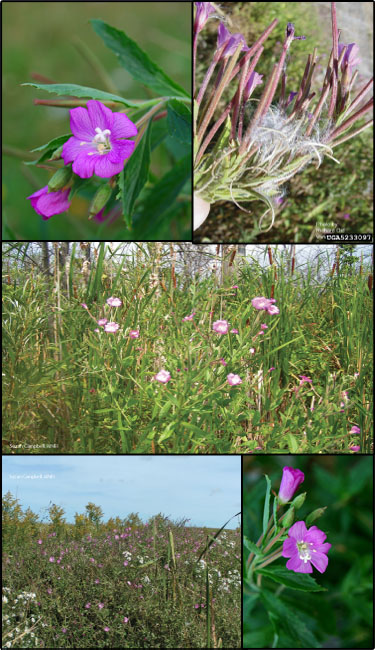European fireweed (Epilobium hirsutum)
 Common Names: Hairy willowherb, codlins and cream, great hairy willow-herb
Common Names: Hairy willowherb, codlins and cream, great hairy willow-herbDescription: Most readily surveyed from July to September while in bloom.
Habit: Herbaceous perennial, coarse, spreading rhizomes; grows from 0.5-2 m (1.6-6.5 ft) in height.
Leaves: Fuzzy, mostly opposite, lanceolate and slightly clasping.
Stems: Erect; fuzzy.
Flowers: Numerous flowers, 4 cleft stigma, 4 notched pink purple or white petals, 3 cm (0.75 in) across.
Fruit and seeds: Seed pod, linear, elongate, splitting to reveal seeds with tufts of fine hairs.
Habitat: Native to Eurasia. Found in wet soils, in open wetland to semi-aquatic settings, meadows, marsh, and edges of lakes, ponds, streams, and rivers.
Reproduction: Primarily by rhizomes, although it also reproduces by wind dispersed seed.
Similar species: Fireweed (Chamerion angustifolium) differs from European fireweed in that its leaves are longer, measuring 15-20 cm(6-8 in) and it does not have pubescent leaves.
Monitoring and rapid response: Hand-pulling or cutting; effectively controlled using any of several readily available general use herbicides. Credits: The Michigan Natural Features Inventory (MNFI) has partnered with MISIN to provide the information in this fact sheet. Species images and/or information were used with permission from "A Field Identification Guide to Invasive Plants in Michigan's Natural Communities" and "A Field Guide to Invasive Plants of Aquatic and Wetland Habitats for Michigan.
Common Name: | European fireweed |
Scientific Name: | Epilobium hirsutum |
Family: | Onagraceae (Evening primrose) |
Duration: | Perennial |
Habit: | Aquatics |
USDA Symbol: | EPHI |
